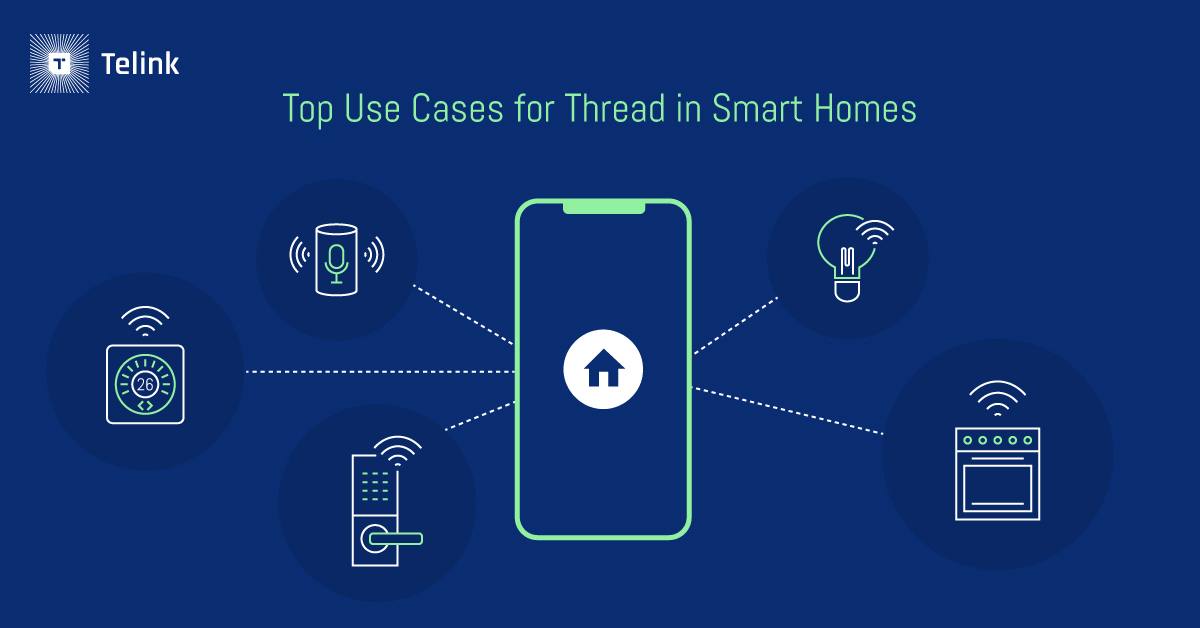


旋转设备


Telink Staff
February 6, 2025
Applications

Low-power, highly secure, and ultra-reliable, here’s why Thread is an essential component for any smart home ecosystem.
Thread is revolutionizing the Internet of Things (IoT) by seamlessly connecting smart home devices to create a more intelligent and cohesive ecosystem. Built on the IEEE 802.15.4 radio standard, this energy-efficient mesh protocol allows smart home devices from different manufacturers to communicate effortlessly, bridging the gap across diverse systems. Its IP-based open standard operating at 2.4 GHz delivers consistent performance and ensures universal compatibility—the cornerstone of future-ready smart homes.
In an age where consumers seek smarter and more versatile technology, Thread enables developers to innovate extensively. Telink currently offers solutions based on the widely adopted Thread 1.3 standard, ensuring robust compatibility and performance for smart home ecosystems.
For a Thread environment to thrive, it must have at least a Mesh Extender (which routes signals between devices) and a Thread Border Route (which connects the Thread Network to other IP-based environments like the internet). These components allow all devices to respond to each other through Thread applications and can facilitate multicast and unicast messaging, all from a mobile device. Thread also includes built-in security at the networking layer, authenticating devices before they join the network, and using MAC encryption for data residing on the network.
One of Thread's key benefits is its ability to self-heal. Thread establishes direct device-to-device, device-to-mobile, and device-to-cloud communications, reducing latency caused by congested traffic and eliminating dropped connections for disruption-proof connectivity. And since Thread is IP-based, there’s no need for proprietary hardware like gateways or translators, helping relieve potential points of failure and maintenance costs.
Low-power and low-latency characteristics also enable battery-powered devices to operate for longer periods of time, reducing the need for frequent battery changes so that you can navigate your devices without interruption. Recently, improvements to the protocol have been made to enhance user experiences and eliminate limitations for product developers.
Thread 1.3 builds on its strong foundation with innovations that enable smarter, more adaptable IoT ecosystems:
With these enhancements, Thread 1.3 sets the stage for seamless integration across smart home devices and naturally aligns with Matter’s mission to simplify and unify the IoT landscape.
Created by the Connectivity Standards Alliance, Matter is a ubiquitous standard designed to universalize all IoT environments. In this way, developers and consumers don’t have to worry about designing or purchasing specific products for their smart home ecosystem to function properly.
As an application layer standard, Matter includes three widely used wireless communication technologies: Thread, Bluetooth® LE, and Wi-Fi. Thread is best for use cases requiring low bandwidth, such as door locks, light bulbs, and thermostats; Bluetooth® LE is for network setup; and Wi-Fi is for high-bandwidth applications like streaming a show from an app on a smart TV.
With Thread’s enhanced multi-fabric support and improved scalability, its integration into the Matter standard further simplifies smart home device interoperability. These advancements allow smart home devices to seamlessly communicate with each other across diverse platforms, making it easier than ever for developers to create intuitive, universally compatible solutions.

In households, IoT makes our lives easier, giving us convenient control over the facets of daily life that give us comfort. And in commercial settings, IoT streamlines productivity through automation and operational efficiency. Here’s how Thread can further augment these experiences:
Stay ahead of the technological curve with Telink’s forward-thinking, highly versatile SoC solutions. Telink’s TL321X, TL721X, and TL751X SoCs are Thread 1.3 Certified Components, providing the space for developers to stretch their creative limits and for consumers to experience what the future of IoT has to offer. Multi-protocol, Matter-supported, and OpenThread compatible, our quality SoCs enable manufacturers to develop products with faster time-to-market and cloud-based updates to keep consumers on pace with the latest trends.
Experience the best of IoT with Telink’s semiconductor chips. Contact us today or email telinksales@telink-semi.com to learn more about how Telink can transform your smart home IoT landscape.